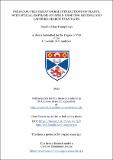Files in this item
Predator-prey behavioural interactions on plants, with special emphasis on aphid dropping defence and ladybird search strategies
Item metadata
| dc.contributor.advisor | Ruxton, Graeme D. | |
| dc.contributor.author | Humphreys, Rosalind Kay | |
| dc.coverage.spatial | 261 | en_US |
| dc.date.accessioned | 2023-03-16T10:18:42Z | |
| dc.date.available | 2023-03-16T10:18:42Z | |
| dc.date.issued | 2022-06-15 | |
| dc.identifier.uri | https://hdl.handle.net/10023/27192 | |
| dc.description.abstract | Predator-prey interactions have significant short- and long-term implications for the individuals involved, their populations’ dynamics, and the broader ecological community. Predation is a strong selective force that has led to prey evolving a great diversity of defensive adaptations, while predators undergo strong selection to successfully locate and capture prey. For both ‘sides’ of these interactions, behavioural adaptations offer flexibility in deployment, and so are expected to be context-sensitive. In this thesis, I use the ladybird-aphid predator-prey system to examine both prey defence behaviours and predator search strategies. Considering the prey, dropping – a widespread but understudied antipredator behaviour – is my focus. My findings suggest that, although dropping seems superficially simple, the selective pressures on it are complex. Dropping is affected by internal factors, such as genotype and the presence of endosymbionts. The nature and proximity of the predatory threat also affect dropping. Further, the consequences of dropping depend on many factors, including where on a plant predator-prey encounters occur; this in turn will be influenced by predator search strategies. Considering predator search, my focus is ladybird movements when searching branched environments, particularly potential turning biases and turn alternation. My work suggests that predators do not follow simple rules when searching a plant for prey, but they may exhibit some innate turning tendencies under particular conditions. Predator search strategies will be highly influential in affecting the context (e.g. location on plant) in which predator-prey interactions take place. Future work should investigate predator search further in order to provide a deeper understanding of the selective pressures on dropping in prey. For both prey dropping and predator search strategies, researchers must also appreciate the context-sensitivity of the different behaviours, and work to understand influencing cues, triggers, and outcomes specific to the species and circumstances involved. | en_US |
| dc.language.iso | en | en_US |
| dc.relation | Predator-prey behavioural interactions on plants, with special emphasis on aphid dropping defence and ladybird search strategies (thesis data) Humpheys, R.K., University of St Andrews, 26 April 2022. DOI: https://doi.org/10.17630/331ad79e-f759-42a5-8bc4-5c1e7609e98f | en |
| dc.relation | ||
| dc.relation | Humphreys, R. K., Ruxton, G. D., & Karley, A. J. (2021). Drop when the stakes are high: adaptive, flexible use of dropping behaviour by aphids. Behaviour, 158, 603-623. https://doi.org/10.1163/1568539x-bja10083 | |
| dc.relation | ||
| dc.relation | Humphreys, R. K., Ruxton, G. D., & Karley, A. J. (2021). Post-dropping behavior of potato aphids (Macrosiphum euphorbiae). Journal of Insect Behavior, First Online. https://doi.org/10.1007/s10905-021-09784-y | |
| dc.relation | ||
| dc.relation | Humphreys, R. K., Neuhäuser, M., & Ruxton, G. D. (2020). Turn alternation and the influence of environmental factors on search routes through branched structures by ladybirds (Coccinella septempunctata and Adalia bipunctata). Behavioural Processes, In-Press, Article 104292. Advance online publication. https://doi.org/10.1016/j.beproc.2020.104292 | |
| dc.relation | ||
| dc.relation | Humphreys, R. K., & Ruxton, G. D. (2020). Do orientation and substrate influence apparent turning biases by the 7-spot ladybird, Coccinella septempunctata? Behaviour, 157(3-4), 205-230. https://doi.org/10.1163/1568539X-00003587 | |
| dc.relation | ||
| dc.relation | Humphreys, R. K., & Ruxton, G. D. (2019). Dropping to escape: a review of an under-appreciated antipredator defence. Biological Reviews, 94(2), 575-589. https://doi.org/10.1111/brv.12466 [Open access version: https://hdl.handle.net/10023/18628] | |
| dc.relation.uri | https://doi.org/10.17630/331ad79e-f759-42a5-8bc4-5c1e7609e98f | |
| dc.relation.uri | https://doi.org/10.1163/1568539x-bja10083 | |
| dc.relation.uri | https://doi.org/10.1007/s10905-021-09784-y | |
| dc.relation.uri | https://doi.org/10.1016/j.beproc.2020.104292 | |
| dc.relation.uri | https://doi.org/10.1163/1568539X-00003587 | |
| dc.relation.uri | https://hdl.handle.net/10023/18628 | |
| dc.rights | Creative Commons Attribution 4.0 International | * |
| dc.rights.uri | http://creativecommons.org/licenses/by/4.0/ | * |
| dc.subject | Antipredator defence | en_US |
| dc.subject | Behavioural ecology | en_US |
| dc.subject | Dropping behaviour | en_US |
| dc.subject | Predator-prey interactions | en_US |
| dc.subject | Aphididae | en_US |
| dc.subject | Coccinellidae | en_US |
| dc.subject | Search strategies | en_US |
| dc.subject | Turning tendencies | en_US |
| dc.subject.lcc | QL758.H8 | |
| dc.subject.lcsh | Predation (Biology) | en |
| dc.subject.lcsh | Aphids--Behavior | en |
| dc.subject.lcsh | Ladybugs--Behavior | en |
| dc.subject.lcsh | Animal-plant relationships | en |
| dc.title | Predator-prey behavioural interactions on plants, with special emphasis on aphid dropping defence and ladybird search strategies | en_US |
| dc.type | Thesis | en_US |
| dc.contributor.sponsor | University of St Andrews. School of Biology | en_US |
| dc.contributor.sponsor | Perry Foundation (Great Britain) | en_US |
| dc.type.qualificationlevel | Doctoral | en_US |
| dc.type.qualificationname | PhD Doctor of Philosophy | en_US |
| dc.publisher.institution | The University of St Andrews | en_US |
| dc.identifier.doi | https://doi.org/10.17630/sta/347 |
The following licence files are associated with this item:
This item appears in the following Collection(s)
Except where otherwise noted within the work, this item's licence for re-use is described as Creative Commons Attribution 4.0 International
Items in the St Andrews Research Repository are protected by copyright, with all rights reserved, unless otherwise indicated.


